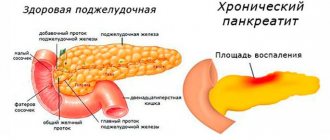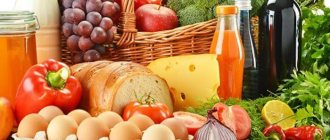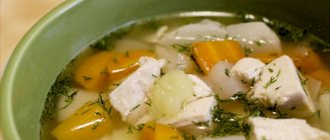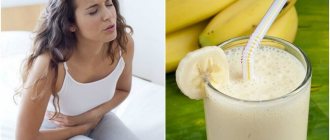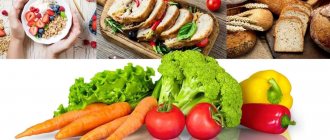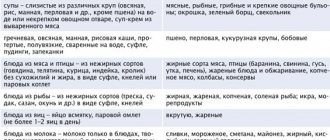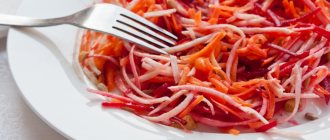Pancreatitis is a severe inflammatory lesion of the pancreas in which the digestive process is disrupted. The causes of the disease can be any, and the pathology itself occurs in several forms. To prevent dangerous consequences and relieve the symptoms of the disease, it is necessary to begin timely therapy, among which a therapeutic diet occupies an important place.
Features of the diet for pancreatitis of the pancreas
The pancreas is the main assistant to proper digestion. Without it, the process of assimilation of food and nutrients is impossible. The organ produces special enzymes, thanks to which products are broken down into simpler substances and are successfully absorbed. Only a healthy gland can cope with this task. With inflammatory lesions, eating fatty, spicy and heavy foods significantly increases the load on the organ and food digestion is disrupted.
When pancreatitis of various clinical forms occurs, it is important not only to eat approved foods, but also to adhere to certain dietary recommendations:
- You should eat in small portions and often up to 5-6 times. It is advisable to eat no more than 300 g at one time.
- In the process of cooking products, they should be subjected to chemical treatment. Therefore, everything that can cause irritation of the organ is completely removed from the patient’s diet. It is recommended to boil, bake or steam food.
- It is important to observe mechanical sparing of the gastrointestinal tract. For this purpose, all food is consumed exclusively in crushed form or grated.
- It is necessary to control your fat intake. Their maximum allowed quantity is 50 g. This volume is evenly distributed among all meals during the day. Various fats are permissible only during the cooking process; fatty foods in their pure form are contraindicated.
- The daily intake of animal protein is no higher than 60% or approximately 200 g per day.
- It is important to remove from the diet foods that provoke the development of flatulence.
- The diet involves limiting salt and salty foods. No more than 3 g per day is allowed.
- You shouldn’t indulge in pure sweets and sugar. Its amount per day should not exceed 40 g. The total amount of carbohydrate food in the diet is 350 g. Sweeteners can be used.
Dish recipes
Nutritionists recommend strictly adhering to dietary rules for any stomach pain. If this is not done, then any of the most effective medications will not help. At the same time, you don’t need to think that all the dishes on this menu are tasteless and boring. You can choose options to suit every taste, while not forgetting about the restrictions and recommendations.
Dietary soups should be on the menu daily. They envelop the walls of the stomach, reduce inflammation, and reduce irritation.
A good lunch would be cauliflower soup.
Cauliflower soup
- Boil one head of cauliflower.
- Prepare the sauce separately: pour 1 tablespoon of flour into a frying pan, add cabbage broth, heat everything thoroughly and mix.
- Grind the finished cabbage in a blender.
- Pour one glass of milk into the mixture. Boil everything.
- Mix one egg, 2.5 teaspoons of sour cream, add to the mixture, let it boil, remove from heat.
- Eat warm.
If you have stomach pain, you have to give up salads made from fresh vegetables, but you should make small changes to your usual recipes, and then you can eat them during your diet.
The vinaigrette
Boil the vegetables: carrots, beets, 2 potatoes. Grind everything thoroughly, add dill and a can of green peas. Add a little salt and vegetable oil.
The classic Olivier salad can be changed a little: instead of sausage, put boiled chicken meat, do not add pickles. Season not with mayonnaise, but with low-fat sour cream.
Fish soufflé
- Boil 140 g of lean fish fillet and chop.
- Pour in 1 tablespoon of milk and egg.
- Add a little salt and butter.
- Cook in a double boiler.
Boiled meat with herbs
- Boil 150 g of prepared lean meat.
- Remove the meat, cool, cut into pieces.
- Decorate with greens.
What can you eat if you have pancreatitis?
According to the diet, in case of inflammatory damage to the pancreas, you can eat:
- Porridges prepared exclusively with water - buckwheat, rice, semolina and with oatmeal.
- Soups - liquid vegetable and puree soup.
- Low-fat dairy products - kefir, cottage cheese, cheese.
- Dietary fish and meat, steamed or baked.
- Vegetables - potatoes, pumpkin, carrots, tomatoes, cucumbers, zucchini, cabbage.
- Fruits that are preferable are not sour and not very sweet - apples, pears, plums, banana.
- Sweets - honey, biscuits, marshmallows.
- Vegetable oil during cooking.
- Steamed eggs without yolk.
- Stale baked goods.
- Homemade vegetable juices, mineral water, weak loose leaf tea.
Reviews and results
Nutritional therapy is meaningless if it is not strictly followed. If with gastritis there is no need for a constant and strict diet, then the presence of pancreatitis dictates the need for constant proper nutrition. Patients feel the need for it, since often an expansion of the diet leads to a deterioration in their health. The complete composition of essential nutrients allows you to adhere to this therapeutic diet for a long time. While on it, patients note an improvement in their condition: pain and flatulence , and stool normalizes. Feedback from patients is only positive, however, difficulties associated with individual cooking and time consumption are noted.
- “... Unfortunately, I follow a diet only during an exacerbation. But I have long excluded some foods - onions and garlic, cabbage, tomato paste and ketchup, mayonnaise and everything connected with it, radishes, radishes, peppers and spicy dishes. After them there is immediate heaviness in the stomach and left side. This list increases with age. Aggravation occurs after feasts and holidays - it is clear that alcohol and excess in food take their toll. On a diet I eat steamed cutlets, boiled meat, fish and neutral cereals. I cook light soups, but with broth. Usually, in order to bring the gastrointestinal tract back to normal, it takes 2-2.5 months, then I expand the diet. It’s not possible to be completely present due to the fact that you need to cook separately for yourself and your household”;
- “... I have had pancreatitis for 10 years, and thanks to the fact that I strictly monitor my diet and take enzymes constantly, I manage to control the disease without exacerbations. A list of foods that the pancreas does not tolerate well has long been compiled: pearl barley and millet porridge, any fried foods, grapes, legumes, cabbage (even boiled), hot seasonings and sauces, I have not eaten mayonnaise for a long time (immediately diarrhea). After so many years, I have adapted to quickly prepare dishes in a double boiler; I can also bake them in the oven, but without fat and crust. The whole family switched to proper nutrition with me, and my husband did not have exacerbations of gastritis”;
- “... I have a whole range of diseases - gastritis, cholecystitis and pancreatitis, so for me proper nutrition is simply necessary. The diet works: after 10 days, the discomfort in the stomach, bloating and rumbling go away. Only nutrition and treatment allow me to feel normal (no pain and normal stool). I have long given up fried and spicy foods; I don’t eat baked goods or puff pastry. I replace all this with crackers, crackers or biscuits. Most often I make steamed cutlets - it’s convenient, quick (I have a 2-tier steamer) and you can take it to work. I see difficulties in the fact that my family does not support me and I have to cook separately.”
What not to eat if you have pancreatitis
In case of any form of pancreatitis, it is prohibited to consume:
- Cereals - legumes, corn, eggs - are difficult to digest.
- Rich fatty soups with the addition of peas, beans and meat.
- Vegetables - peppers, onions, eggplants.
- Hot and sour sauces, mayonnaise, ketchup, horseradish and mustard.
- Fatty meats and fish, smoked meats, sausage.
- Sweets - yeast products, fresh bread, cream, chocolate.
- Drink - sour and sweet juices, any coffee, black tea, alcoholic drinks.
What is recommended to avoid?
Prohibited foods for pancreatitis include those that are difficult and take a long time to digest, and are also strong irritants of the gastrointestinal tract and, accordingly, the pancreas:
- rich meat, fish and mushroom broths and soups;
- smoked varieties of sausages and smoked products in general;
- canned food and marinades;
- fresh baked goods and bread;
- spinach, sorrel, garlic, radish, radish;
- raw vegetables;
- vinegar, mustard, pepper;
- hot and spicy sauces and seasonings;
- alcohol, strong tea and coffee.
This list is general; it can be expanded due to the characteristics of the body, the course of the disease, the form of pancreatitis (acute or chronic in remission), as well as the age and nutritional status of the patient.
Diet for acute pancreatitis of the pancreas
In acute pancreatitis, especially in the acute stage, it is important to provide the patient with complete rest. During this period, fasting is recommended to reduce the load on the pancreas. Therefore, in the first 1-3 days, intravenous infusions are prescribed to maintain the vital functions of the body. If there is no nausea and vomiting, give Essentuki, Borjomi water or weak warm tea, decoction up to 1-1.5 liters per day. Depending on the condition, on day 2-3 the patient is allowed to eat normally, but in small portions.
A diet for acute inflammation of the organ involves the consumption of vegetable soups, lean meat and fish, and purees of semi-sweet, non-acidic fruits and vegetables. Drinks that are allowed are jelly, compotes, rosehip decoction, and weak brewed tea. Fats and salt should be excluded when preparing dishes.
Fully or partially limited products
- Pickled and pickled vegetables, canned food of any kind, including vegetables, since these products stimulate the secretion of gastric and pancreatic juice.
- Fried foods (meat, scrambled eggs, fried pies, pancakes, pancakes, cheesecakes), fatty meat and fish, goose and duck meat, sausages, canned food, smoked meats, fish caviar, offal (due to high cholesterol content), cooking fats, lard.
- Raw vegetables and fruits at the initial stage of the diet - only baked or stewed ones are recommended. Later, raw vegetables are introduced very carefully and in small quantities.
- Coarse and irritating vegetables are excluded on a permanent basis: turnips, radishes, radishes, white cabbage, legumes, rutabaga, sorrel, onions, mushrooms, as a difficult-to-digest product.
- Tomatoes are possible if tolerated well.
- Hot seasonings and spices, sauces (meat and tomato), horseradish, mustard, ginger, pepper.
- Connective tissue products - skin, cartilage, tendons and fascia.
- Sweet fruits (such as grapes, bananas, dates and raisins) because they cause bloating.
- Cabbage soup, borscht, strong broths, okroshka.
- Millet, barley, pearl barley and corn, coarse types of pasta.
- Strong coffee, chocolate, jam, ice cream, cocoa, grape juice, alcohol, carbonated drinks.
- Fresh bread, black, baked goods.
- High acidity dairy products, sour fruits and berries.
Table of prohibited products
| Proteins, g | Fats, g | Carbohydrates, g | Calories, kcal | |
Vegetables and greens | ||||
| vegetables legumes | 9,1 | 1,6 | 27,0 | 168 |
| canned vegetables | 1,5 | 0,2 | 5,5 | 30 |
| eggplant | 1,2 | 0,1 | 4,5 | 24 |
| swede | 1,2 | 0,1 | 7,7 | 37 |
| cabbage | 1,8 | 0,1 | 4,7 | 27 |
| sauerkraut | 1,8 | 0,1 | 4,4 | 19 |
| green onion | 1,3 | 0,0 | 4,6 | 19 |
| bulb onions | 1,4 | 0,0 | 10,4 | 41 |
| cucumbers | 0,8 | 0,1 | 2,8 | 15 |
| canned cucumbers | 2,8 | 0,0 | 1,3 | 16 |
| white radish | 1,4 | 0,0 | 4,1 | 21 |
| turnip | 1,5 | 0,1 | 6,2 | 30 |
| canned tomatoes | 1,1 | 0,1 | 3,5 | 20 |
| horseradish | 3,2 | 0,4 | 10,5 | 56 |
| spinach | 2,9 | 0,3 | 2,0 | 22 |
| sorrel | 1,5 | 0,3 | 2,9 | 19 |
Fruits | ||||
| bananas | 1,5 | 0,2 | 21,8 | 95 |
Berries | ||||
| grape | 0,6 | 0,2 | 16,8 | 65 |
Mushrooms | ||||
| mushrooms | 3,5 | 2,0 | 2,5 | 30 |
| marinated mushrooms | 2,2 | 0,4 | 0,0 | 20 |
Nuts and dried fruits | ||||
| nuts | 15,0 | 40,0 | 20,0 | 500 |
| raisin | 2,9 | 0,6 | 66,0 | 264 |
| seeds | 22,6 | 49,4 | 4,1 | 567 |
| dates | 2,5 | 0,5 | 69,2 | 274 |
Cereals and porridges | ||||
| corn grits | 8,3 | 1,2 | 75,0 | 337 |
| pearl barley | 9,3 | 1,1 | 73,7 | 320 |
| millet cereal | 11,5 | 3,3 | 69,3 | 348 |
| barley grits | 10,4 | 1,3 | 66,3 | 324 |
Flour and pasta | ||||
| pasta | 10,4 | 1,1 | 69,7 | 337 |
Bakery products | ||||
| buns | 7,9 | 9,4 | 55,5 | 339 |
| Rye bread | 6,6 | 1,2 | 34,2 | 165 |
Confectionery | ||||
| candies | 4,3 | 19,8 | 67,5 | 453 |
| pastry cream | 0,2 | 26,0 | 16,5 | 300 |
| shortbread dough | 6,5 | 21,6 | 49,9 | 403 |
Ice cream | ||||
| ice cream | 3,7 | 6,9 | 22,1 | 189 |
Cakes | ||||
| cake | 4,4 | 23,4 | 45,2 | 407 |
Chocolate | ||||
| chocolate | 5,4 | 35,3 | 56,5 | 544 |
Raw materials and seasonings | ||||
| mustard | 5,7 | 6,4 | 22,0 | 162 |
| ginger | 1,8 | 0,8 | 15,8 | 80 |
| ketchup | 1,8 | 1,0 | 22,2 | 93 |
| mayonnaise | 2,4 | 67,0 | 3,9 | 627 |
| ground black pepper | 10,4 | 3,3 | 38,7 | 251 |
| chilli | 2,0 | 0,2 | 9,5 | 40 |
Dairy | ||||
| milk 4.5% | 3,1 | 4,5 | 4,7 | 72 |
| cream 35% (fat) | 2,5 | 35,0 | 3,0 | 337 |
| whipped cream | 3,2 | 22,2 | 12,5 | 257 |
| sour cream 30% | 2,4 | 30,0 | 3,1 | 294 |
Meat products | ||||
| fatty pork | 11,4 | 49,3 | 0,0 | 489 |
| salo | 2,4 | 89,0 | 0,0 | 797 |
| bacon | 23,0 | 45,0 | 0,0 | 500 |
| ham | 22,6 | 20,9 | 0,0 | 279 |
Sausages | ||||
| dry-cured sausage | 24,1 | 38,3 | 1,0 | 455 |
Bird | ||||
| smoked chicken | 27,5 | 8,2 | 0,0 | 184 |
| duck | 16,5 | 61,2 | 0,0 | 346 |
| smoked duck | 19,0 | 28,4 | 0,0 | 337 |
| goose | 16,1 | 33,3 | 0,0 | 364 |
Fish and seafood | ||||
| dried fish | 17,5 | 4,6 | 0,0 | 139 |
| smoked fish | 26,8 | 9,9 | 0,0 | 196 |
| black caviar | 28,0 | 9,7 | 0,0 | 203 |
| salmon caviar granular | 32,0 | 15,0 | 0,0 | 263 |
| canned fish | 17,5 | 2,0 | 0,0 | 88 |
Oils and fats | ||||
| animal fat | 0,0 | 99,7 | 0,0 | 897 |
| cooking fat | 0,0 | 99,7 | 0,0 | 897 |
Alcoholic drinks | ||||
| dry red wine | 0,2 | 0,0 | 0,3 | 68 |
| beer | 0,3 | 0,0 | 4,6 | 42 |
Non-alcoholic drinks | ||||
| bread kvass | 0,2 | 0,0 | 5,2 | 27 |
| cola | 0,0 | 0,0 | 10,4 | 42 |
| sprite | 0,1 | 0,0 | 7,0 | 29 |
Juices and compotes | ||||
| grape juice | 0,3 | 0,0 | 14,0 | 54 |
| * data is per 100 g of product | ||||
